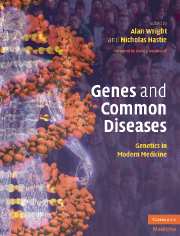Book contents
- Frontmatter
- Contents
- List of Contributors
- Foreword
- Section 1 Introductory Principles
- 1 Genes and their expression
- 2 Epigenetic modification of chromatin
- 3 Population genetics and disease
- 4 Mapping common disease genes
- 5 Population diversity, genomes and disease
- 6 Study design in mapping complex disease traits
- 7 Diseases of protein misfolding
- 8 Aging and disease
- 9 The MHC paradigm: genetic variation and complex disease
- 10 Lessons from single gene disorders
- 11 Environment and disease
- 12 Contemporary ethico-legal issues in genetics
- Section 2 Common Medical Disorders
- Index
- References
6 - Study design in mapping complex disease traits
Published online by Cambridge University Press: 17 August 2009
- Frontmatter
- Contents
- List of Contributors
- Foreword
- Section 1 Introductory Principles
- 1 Genes and their expression
- 2 Epigenetic modification of chromatin
- 3 Population genetics and disease
- 4 Mapping common disease genes
- 5 Population diversity, genomes and disease
- 6 Study design in mapping complex disease traits
- 7 Diseases of protein misfolding
- 8 Aging and disease
- 9 The MHC paradigm: genetic variation and complex disease
- 10 Lessons from single gene disorders
- 11 Environment and disease
- 12 Contemporary ethico-legal issues in genetics
- Section 2 Common Medical Disorders
- Index
- References
Summary
Introduction
The current rate of advances in genetic technology and statistical methods makes it difficult to discuss study design in mapping complex disease traits in a way that will have value beyond a relatively short time horizon. This chapter considers how knowledge about the nature of complex diseases and traits can inform study design and confines itself to genomic (rather than proteomic or metabonomic) approaches.
Genetic influences on complex traits can be considered in terms of susceptibility to disease (clinical and pre-clinical), susceptibility to differences in natural history of disease (severity, complications and prognosis), susceptibility to different therapeutic responses (efficacy and adverse effects) or in terms of the genetic determinants of normal phenotypic variation in health.
The choices between approaches depend not only on the context of the study, but also on the relative costs of ascertaining families, measuring phenotypes and genotyping. The costs of genotyping have been falling rapidly over the last decade and the trend is for genotyping to be done in a few automated high-throughput centres to maximize efficiency. In contrast, more stringent ethical and data protection legislation requirements have tended to increase unit recruitment costs, since ascertainment and recruitment procedures become more demanding and remain very labor intensive. It is likely therefore that the requirements for very large sample sizes and for large collaborative studies will increasingly involve research groups from countries of intermediate development which can assure high fidelity phenotyping, but at much lower cost than is possible in most industrialized nations.
- Type
- Chapter
- Information
- Genes and Common DiseasesGenetics in Modern Medicine, pp. 92 - 112Publisher: Cambridge University PressPrint publication year: 2007



